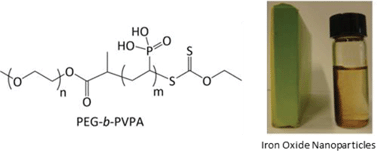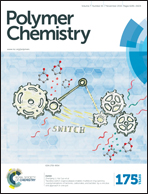Advantages of poly(vinyl phosphonic acid)-based double hydrophilic block copolymers for the stabilization of iron oxide nanoparticles†
Abstract
Poly(ethylene glycol)–poly(vinylphosphonic acid) block copolymers (PEG-b-PVPA) of low average molar mass were synthesized by RAFT/MADIX polymerization. Their intrinsic properties (i.e. anionic-neutral character which brings both ability to strongly interact with cations and steric stabilization) allow the one-step in situ synthesis of water-dispersible iron oxide nanoparticles with controlled size and high colloidal stability. The effect of structural properties of the polymer (chain length of PEG and PVPA blocks) on the formation and/or stabilization of nanoparticles has been evaluated. Additionally, PVPA and PAA block complexing abilities were compared and the advantage of phosphonic acid groups over carboxylic acid groups was proven. Hemocompatibility tests carried out with the DHBCs alone and DHBC/iron oxide hybrid nanoparticles revealed that the hemolysis rates observed with phosphonated copolymers were much lower than for their carboxylated analogs.


 Please wait while we load your content...
Please wait while we load your content...